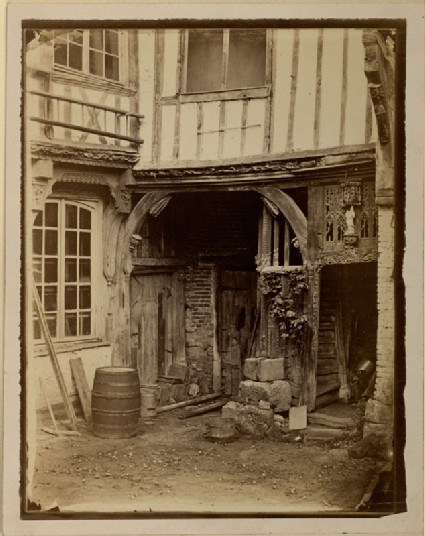Browse: 1470 objects
- Reference URL
Actions
Copy...
The Courtyard of a Late Gothic Wooden House at Abbeville John Ruskin
-
Details
- Artist/maker
-
John Ruskin (1819 - 1900) (photographer)
- Object type
- photograph
- Material and technique
- albumen print
- Dimensions
- 223 x 173 mm (print); 237 x 188 mm (mount)
- Inscription
- On the back of the mount, centre, the Ruskin School's stamp
- Provenance
-
Presented by John Ruskin to the Ruskin Drawing School (University of Oxford), 1875; transferred from the Ruskin Drawing School to the Ashmolean Museum, c.1949.
- No. of items
- 1
- Accession no.
- WA.RS.ED.062
-
Subject terms allocated by curators:
Subjects
-
References in which this object is cited include:
References
Ruskin, John, Catalogue of the Educational Series (London: Smith, Elder, 1871), cat. Educational no. 30.H
Ruskin, John, Catalogue of the Educational Series (London: Spottiswoode, 1874), cat. Educational no. 62
Ruskin, John, ‘Rudimentary Series 1878’, 1878, Oxford, Oxford University Archives, cat. Rudimentary no. 289
Ruskin, John, ‘The Ruskin Art Collection at Oxford: Catalogues, Notes and Instructions’, Edward T. Cook and Alexander Wedderburn, eds, The Works of John Ruskin: Library Edition, 39 (London: George Allen, 1903-1912), 21, cat. Educational no. 62
Location
-
- Western Art Print Room
Position in Ruskin’s Collection
Ruskin's Catalogues
-
Ruskin's Educational series, 1st ed. (1871)
30 H Wooden domestic Architecture. Late Gothic, at Abbeville. P -
Ruskin's Educational series, 2nd ed. (1874)
62. Wooden domestic Architecture. Late Gothic, at Abbeville. P -
Ruskin's revision to the Rudimentary series (1878)
Edu. 62 289.The group through which we have passed gives examples only of Foliage seen close at hand, such as the great Masters associate with Figures of the life-size. We now begin the study of Effects of Foliage diminished in distance, and which therefore cannot be completed in the Methods hitherto exhibited. I take, therefore, an actual group of leaves, vine, seen in this Photograph at a distance of about twenty-five feet, and therefore necessarily losing, if proR. perly represented, all clear lines of organization. Though the Photograph exaggerates the shadows, it gives us in other respects accurately the conditions of Mystery required at such distance; which, generally speaking, will be that of an ordinary Landscape-foreground. I take the group here shown in association with French Sculpture that the student may learn the qualities of good Painting and Sculpture at once. When he has learned to draw these leaves as the Photograph represents them, he will know how to admire the imaged leaves carved at the side of them.








